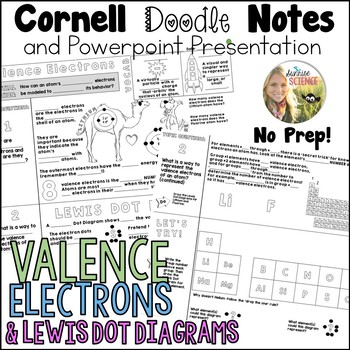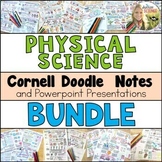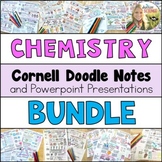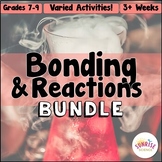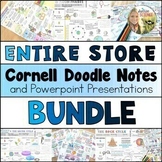Valence Electrons Lewis Dot Diagrams Doodle Notes | Cornell Notes
- Zip
What educators are saying
Also included in
- This is a growing bundle of all of my Physical Science Cornell Doodle Notes. This resource currently contains Cornell Doodle Notes and the associated Powerpoint / Google Slides Presentations for Physical Science 28 topics. The price at this point reflects only what is in the bundle at this time, pluPrice $103.00Original Price $144.12Save $41.12
- This is a growing bundle of all of my Cornell Doodle Notes on Chemistry topics. This resource currently contains Cornell Doodle Notes and the associated Powerpoint / Google Slides Presentations for 21 topics.✨ If you buy this bundle today, you are receiving 20% off on the current resources, plus youPrice $87.00Original Price $109.15Save $22.15
- Looking for fun and engaging ways to teach your students about chemical bonding and reactions?This bundle contains 17+ activities (including one *bonus* activity) and 5 assessments to help you teach and assess the following topics:Counting Atoms in Chemical FormulasValence Electrons/Lewis Dot DiagraPrice $50.00Original Price $67.90Save $17.90
- This is a bundle of all of my resources for teaching chemistry concepts at the 8th / 9th grade level, including laboratory equipment and safety, states, properties and changes in matter, atoms and the periodic table, and bonding and chemical reactions. These resources include a mix of Cornell DoodlePrice $195.00Original Price $252.47Save $57.47
- This is a bundle of all of my resources for teaching physical science at the middle school level! These resources include a mix of Cornell Doodle Notes, labs, demonstrations, inquiry activities, self-paced digital 5E lessons, manipulatives, projects, pixel art review activities, and assessments. IPrice $297.00Original Price $384.06Save $87.06
- This is a growing bundle of ALL of my Science Cornell Doodle Notes resources. This bundle currently contains Cornell Doodle Notes and the associated Powerpoint / Google Slides Presentations for 48 science topics. The price at this point reflects what is in the bundle at this time, plus 20% off. As aPrice $189.00Original Price $244.25Save $55.25
- This mini-bundle contains three sets of Cornell Doodle Notes for teaching or reviewing about Chemical Bonding! The topics included are: Valence Electrons, Ions and Ionic Bonding, and Covalent Bonding. Get 20% off of these resources by purchasing them in this bundle!Here are some things to know aboutPrice $10.95Original Price $13.69Save $2.74
Description
These scaffolded Cornell Doodle Notes combine two effective note-taking strategies and can be used as a mini-lesson on how to draw a Lewis Dot Diagram to show the valence electrons of an atom. There is a Let’s Try practice space in which students draw the Lewis Dot Diagrams for elements #1-18.
These notes can be used as part of the input for NGSS HS-PS1-1: Use the periodic table as a model to predict the relative properties of elements based on the patterns of electrons in the outermost energy level of atoms and NGSS Disciplinary Core Idea PS1.A: The structure and interactions of matter at the bulk scale are determined by electrical forces within and between atoms.
Cornell Notes are a note-taking strategy in which topic questions are written in a narrow left-hand column and definitions, explanations, and diagrams are filled in in the right-hand column.
Doodle Notes (or Sketch Notes) are another note-taking strategy for which pictures and graphics activate the visual pathways of the brain, which helps with retention of information when compared to standard note-taking. Your visual learners will really benefit from seeing and coloring in the pictures aside the main points of the notes!
I created a Powerpoint that goes with these notes. The Powerpoint walks the students through the lesson from the Essential Question and through all of the Topic Questions. This Powerpoint is included in the download. While it is not editable due to font and clip art licensing agreements, you can always add extra slides for additional pictures that you contribute, or extra text boxes that include information that you’d like your students to write on their notes!
Including the practice problems page, these Cornell Doodle Notes are 2-pages and there are 2 scaffolded versions plus the answer key included. You can use the 'print on long edge' printer setting to keep the left and right columns aligned when your students flip the page (printing instructions included).
The Powerpoint is included and there are also directions for accessing the presentation via Google Drive (Google Slides). This is obviously optional depending on how you choose to use this in your classroom.
Learn how to separate the differentiated versions of these notes in your Google Drive and how to assign them digitally using Google Classroom by downloading THIS FREEBIE!
Here are some ways that I suggest using this product:
✎ Whole-Group lesson with scaffolding : decide which students should receive which level of the notes. Hand out the notes to the students. Use the Powerpoint as a presentation and talk aloud through the lesson while the students take notes. Allow them to color/doodle further after each section and at the end of the lesson. {If you have a document camera (an ELMO), you can fill out your own notes and the students can follow along with you as you discuss the concepts aloud!}
✎ Scaffolded Small-Group lesson : separate your students into groups by learning level. Give each student group sets of the appropriate notes for their level. Make sure each group has a device to view the presentation. Post the Powerpoint or Google Slides to your Google Classroom or other online learning platform, or email the Powerpoint version to one ‘student leader’ in each group. The students would view the Powerpoint/Slides together on one device and fill in the notes. . Encourage them to add color/further notes.
✎ Individual Note-Taking or Flipped Classroom : Post the Powerpoint to your Google Classroom or other online learning platform or hand out the Google access directions to your students.. Hand out the appropriate-level notes to each student. Students can work at their own pace to view the presentation and complete their notes. Encourage them to add color/further notes.
Please note that this resource is not editable due to font and clip art licensing agreements.
Doodle notes is a trademarked term used with permission. Please visit doodlenotes.org for more information.
You may also be interested in these resources for teaching about bonding:
Covalent Bonding Cornell Doodle Notes and Powerpoint
Covalent Bonding Manipulative Puzzles Activity
Ions and Ionic Bonding Cornell Doodle Notes and Powerpoint
Ionic Bonding Manipulatives Activity
Counting Atoms in Chemical Formulas Abracadabra Pixel Art Digital Review
Ingredient Labels of Everyday Products Chemical Compounds Research Project
Thanks for looking!
Sunrise Science

